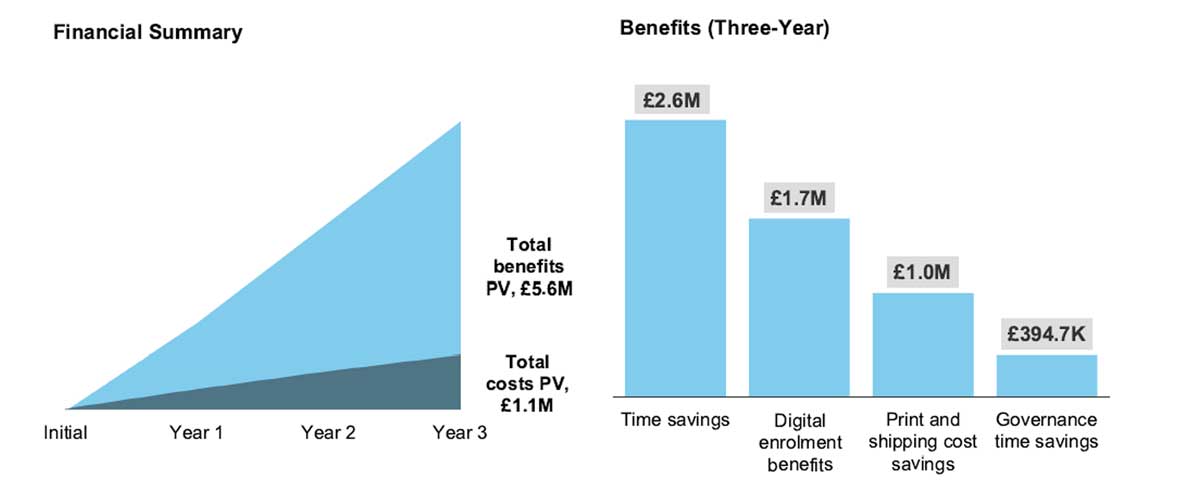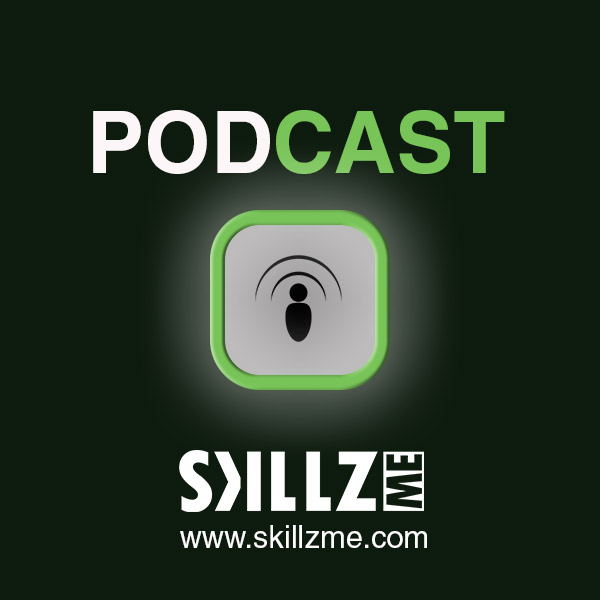
A Forrester Total Economic Impact study commissioned by Adobe in August 2019. Forrester looked in this study into the cost savings and business benefits enabled by Adobe Sign, the e-signature solution by Adobe. The project was carried out by Sarah Musto and Connor Maguire.
Executive Summary
To better understand the benefits, costs, and risks associated with this investment, Forrester interviewed several customers with years of experience using Adobe Sign. Adobe Sign, part of Adobe Document Cloud, provides e-signature capabilities that allow organizations to digitally send, sign, track, and manage documents that require a signature.
Additionally, Adobe Sign can be used for internal or web forms to gather critical information. Users can easily fill out and return forms on any device or browser. Forrester examined the use of Adobe Sign in various lines of business as well as its use to digitize companies’ enrolment processes, expediting customer and employee onboarding.
Prior to using Adobe Sign, the interviewed organizations managed document signatures with mostly manual processes, using a combination of paper, faxing, scanning, and shipping to acquire said signatures.
“50% of all our agreements that we conduct electronically are completed within 1 hour. We also know that 70% of all agreements are completed within 1 day. Physical agreements cannot match the speed at which we can get agreements signed electronically. – Product manager, technology provider
Employees spent significant amounts of time waiting for documents to be returned and attempting to monitor the status of documents pending signature. Employees frequently found themselves having to resend documents that were lost or not filled out correctly, thus increasing the cycle time and creating inefficiencies. Users both internally and externally were often faced with lengthy delays caused by executive travel and other circumstances that would cause signers to leave their offices, making them unavailable for a signature until they returned. The organizations found that for both employees and for customers, these manual processes increasingly fell short of expectations and had a negative impact on the overall experience of all parties involved.
With Adobe Sign, interviewees described how they have converted their formerly paper processes into digital processes, which reduce, among other things, the amount of forms that need to be printed and shipped. Using Adobe Sign, the interviewed organizations have templatized many of their forms, creating standard workflows for editing and generating new documents. The organizations now use the mobile capabilities of Adobe Sign to reach users who are frequently out of the office. This capability reduces the amount of time users spend waiting for signatures to come back and significantly reduces the cycle times of these workflows.
Organizations have also integrated Adobe Sign with their Microsoft Office 365 applications to improve adoption, enabling e-signature functionality within the tools that employees use every day. Overall, the Adobe Sign investment improves the signature experience for internal and external audiences, simplifying these previously manual processes and making it easier to get documents signed.
Key Challenges
The interviewed organizations experienced common challenges prior to investing in Adobe Sign, including:
- Signature processes that did not meet employee or customer expectations. Manual processes prevented employees from completing tasks quickly, reducing the time they could spend on high impact work. Employees who traveled frequently or worked remotely needed a solution that was easy to use on a mobile device and didn’t require access to printers or fax machines. Interviewees with employees across different regions needed a faster way than shipping to sign off on important documents. Customers increasingly expected more digital and mobile experiences, and this expectation extended to signature processes.
- Inefficient signature processes that resulted in long signature cycles. Interviewees highlighted inefficiencies from preparing, printing, mailing, scanning, faxing, and tracking documents manually. Paper documents were more likely to be lost, extending signature cycles.
Once organizations received signatures, employees spent time on re-entry of data into systems, scanning documents to store electronically, or filing documents in physical filing cabinets. - Expensive existing signature processes. Existing signature processes required spending on paper, printers, ink, fax machines, and postage or shipping rates. The rates could be costly depending on the volume of documents interviewed organizations were sending annually.
- Security and compliance challenges posed by signature processes interrupted with paper-based tasks. Interviewees noted that paper documents with sensitive information were easily lost and didn’t always go directly to relevant parties. Paper documents were also more difficult to update when text around compliance and regulation needed to be altered. Employees had to locate source files and ensure that all forms were sent out with the correct updated text, which was difficult to do without standardized digital forms.
- Implementations of IT solutions in enterprises. Signature processes require to be legally binding. Implementing a solution in this field shy away organizations because of a lack of understanding of the risks of implementing a digital signature solution.
Key Results
The interviews revealed that key results from the Adobe Sign investment include:
Reduced signature cycle times. Interviewees have experienced significant reductions in overall cycle times to obtain a signature. These reductions come from the use of mobile functionality to sign documents when working remotely, fewer cycles by reducing errors and rework associated with errors, automation of manual e-signature workflows directly within Microsoft applications, and easily templatized forms that limit the amount of customization that needs to be completed by end-users.
Less time spent on signature processes. By using templates, tracking and notification features, signature workflows, and integrations between Adobe Sign and systems of record, employees spend less time preparing documents, negotiating, tracking documents, re-entering data, and storing documents.
Less time spent enrolling new customers. By digitizing their enrolment processes, interviewees can now save additional time not captured in a typical Adobe Sign transaction. Lengthy and complicated enrolment processes can be completed in a fraction of the time needed for legacy workflows. Using digitized forms streamlines the customer experience and eliminates errors and delays produced from manual processes that require duplicate data entry. This creates a better overall customer experience and leads to fewer customers dropping out of enrolment processes.
Cost savings from less paper usage. Digital processes reduce costs for paper, ink, printers, and shipping. Customers have also accrued savings by avoiding the cost of storing their documents in a physical location.
Improved compliance. Interviewees find it significantly easier to update and maintain documents with Adobe Sign. This makes updating documents that are subject to strict and rapidly changing compliance regulations a less complex and more thorough process. Interviewed organizations no longer worry that forms with incorrect and outdated text are being sent as all forms are standardized with templates.
Digital Transformation adoption throughout the organization. Interviewees noted several different methods through which Adobe Sign use and benefits have spread throughout their organizations. Most organizations have top-down initiatives, where executives champion the use of Adobe Sign to the teams they interact with. This was found to be the most effective way to get new teams to start using Adobe Sign. The benefits of using Adobe Sign also spread through word of mouth among employees, and administrators actively promote the use of Adobe Sign and identify new use cases. Some interviewees found that a fast way to introduce employees to Adobe Sign is by using Adobe Sign for HR documents. Due to Adobe Sign’s ease of use and ability to easily scale, new users, can access and start using Adobe Sign very quickly, accelerating overall benefits.
All the key results are analyzed in detail in the whitepaper “The Total Economic Impact of Adobe Sign” from Forrester for download here.

The Total Economic Impact of Adobe Sign: Adobe Sign Cost vs Return of Investment on benefits over 3 years.
Unquantified Benefits
In some cases, we can not calculate benefits in productivity or money savings. Implementing Adobe Sign in an organization brings benefits to organizations that might be seen as beneficial or valuable over time. In the “The Total Economic Impact of Adobe Sign” study the interviewees also identified the following benefits.:
- Improved customer experience due to modernization
- Streamlined HR, sales, and legal processes
- Reduced environmental impact through the reduction in paper
Return of your Investment
Adobe is proven to deliver immediate benefits and value to and across any enterprise. The Total Economic Impact of Adobe Sign can be seen in many cases and proof of the worldwide initiatives to move towards a paperless office environment.
According to the published Forrester Total Economic Impact studies, customers using an Adobe solution, on average, can expect the benefit from: improved revenue performance, IT cost savings, and improved business efficiency and agility.
Furthermore, based on those same studies, companies can expect that the more solutions they utilize from Adobe, the greater impact and value companies can realize.
More Links
- Read in our Skillz Blog, 101: Digital Signature and Adobe Sign [Infographic].
- Read in our Skillz Blog, 102: The History Of Digital Signatures [Infographic].
- Read in our Skillz Blog, Top 3 Pitfalls when Implementing a Digital Signature.
- Read in our Skillz Blog, Electronic Signatures vs. Digital Signatures – Defining the Difference [Infographic].

![8 Predictions for AI in 2024 [Infographic] hero-image-8-Predictions-for-AI-in-2024](https://www.skillzme.com/wp-content/uploads/2024/01/hero-image-8-Predictions-for-AI-in-2024-200x200.jpg)
![6 Exciting eLearning Trends for 2024 [Infographic] 6 Exciting eLearning Trends for 2024](https://www.skillzme.com/wp-content/uploads/2024/01/hero-image-6-Exciting-eLearning-Trends-for-2024-200x200.jpg)
![What’s Ahead In 2024 For The Future Of Work? [Infographic] hero-image-What’s-Ahead-In-2024](https://www.skillzme.com/wp-content/uploads/2024/01/hero-image-Whats-Ahead-In-2024-200x200.jpg)


Thanks for sharing the helpful information. Definitely using would help you get your point across without being repetitive. This is what i was looking for thanks for sharing amazing post with great & helpful information keep up great work.
Thank you Oliver for your kind words, will be looking forward to creating more relevant content in the future, cheers